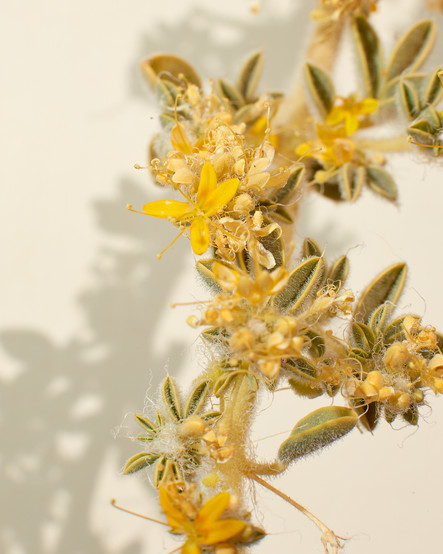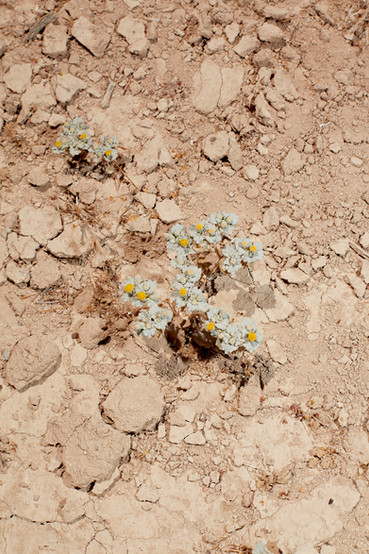A July Day at Lake Thompson
- Plants LAcounty
- Aug 6, 2023
- 4 min read
Updated: Aug 7, 2023

About 5-7 million years ago, the San Gabriels began to rise as a result of tectonic plate movement along the San Andreas fault. The new mountains reversed the flow for many rivers north of the range, forming a 950km2 body of water that modern scientists have named Lake Thompson. Much of present day NE LA County, including the city of Lancaster, was covered by the lake until about 17k year ago. It was then the climate began to warm and the water sources dried up.
As Lake Thompson evaporated, the salts in the water concentrated and mixed into the soil. Salt is hard for plants. Roots rely on osmosis and when the concentration of salts in the soil is higher than inside the plant, the water flow stops. Most plants are unable to tolerate salt and have to grow elsewhere. This opens up large areas with reduced competition for any plants that can adapt to the conditions. Botanists call these salt-adapted plants Halophytes. Salt tolerance has evolved in many plant groups, yet is still not common. only 2% of plant taxa worldwide are considered halophytes.

In their The Vegetation and Flora of Edwards Air Force Base, Western Mojave Desert (2017), David Charlton and Philip W. Rundel cover most of the area of Lake Thompson. They found that the present day soils of the former lake tend to harbor Saltbush Scrub, a plant community defined by dominance of plants in the genus Atriplex.
Charlton and Rundel observed 11 native Atriplex taxa while surveying for their project, with a few species having clear preferences for where to grow in the different microhabitats of the lake bed. They found that Atriplex polycarpa usually occupied the less saline transitional zones between the Creosote and the rest of the playa. Atriplex canescens preferred deep sand. Atriplex confertifolia occurred in “deflated dunes with sandy hummocks and pans”. Atriplex spinifera occured in spots that “have been eroded by flood events to produce shallow sands over the soil surface.” Atriplex torreyi liked clay drainages and Atriplex parryi was restricted to “depressions and small pans.”
This trip, I shot Atriplex confertifolia (Shadscale) in what I'm assuming was a "deflated dune and sandy pan" zone. It's a short perennial, growing less than a meter, with distinct foliage. Shadscale, like other Atriplex plants, is highly nutritious and an important food source for seemingly all birds and mammals where it grows. Gallery for Atriplex conferifolia below.
Mixed in with the Shadscale were some Suaeda nigra (Mojave Seablite) and Sporobolus airodes (Alkali Scaton) plants. There are 5 taxa of Suaeda in LA County with 3 listed as rare plants. Nearly all have been observed near the coast with S. nigra being the most common version inland. Like other halophytes, the genus is very high in antioxidants and the protective chemicals help the plants survive the harsh growing conditions.
Similar to Shadscale, Akali Scaton is an important food source for animals and even "relished by jack rabbits." Adding further proof to the importance of preserving biodiversity, a bacteria from the root microbiome of Alkali Scaton was found to be effective at inhibiting the growth of root rot pathogens that affect other plants including agricultural crops.
Gallery for Suaeda nigra and Sporobolus airodes below.
I drove down the road a couple miles until I saw some Sunflower relatives. They turned out to be Grindelia camporum (Great Valley Gumweed) and Centromadia pungens ssp. pungens (Common Spikeweed). Great Valley Gumweed is an important medicinal plant for indigenous peoples, used topically for a variety of reasons. The sticky resin on the flower heads has a most of the good chemicals and is actually made of diterpene acids. The gum can be up to 10% of the plants dry weight, making it highly productive.
The spikes on Common Spikeweed were indeed very sharp and painful to touch. There are 4 Centromadia taxa in LA County with 3 listed as rare. One of the rare Centromadia is listed as CRPR 1B.2, and the other two are 1B.1. Centromadia pungens ssp. pungens is the only “common” one and it was my first time seeing it.
Gallery for Grindelia camporum and Centromadia pungens ssp. pungens below.
After the Sunflower stop, I drove to another area to look for Cleomella obtusifolia (Mojave Stinkweed). I lucked out and found it covering the roadside close by. Mojave Stinkweed is a low growing cousin of the more common Peritomea arborea (Bladderpod) and I see the resemblance in the flowers. The plant does indeed smell bad but it's hard to describe. Gotta go smell it for yourself.
Mixed into the Stinkweeds were tiny, silver plants that looked very familiar. I thought they were some common Ambrosia seedlings at first glance but they turned out to be Psathyrotes annua (Annual Turtleback). I saw the same plants growing with Mojave Stinkweed at Owens Lake last summer in very similar and salty conditions. This sighting of Annual Turtleback turned out to be the first in LA County. The seeds could have come from a car or some other non-native way but it does make me think our portion of Lake Thompson needs some more botanizing. Have we seen all it has to offer?
Gallery for Cleomella obtusifolia and Psathyrotes annua below.
After looking at the Turtlebacks, I realized it was 105F at 1:30PM and it was time to head home. After just 5 minutes of driving (still in Lake Thompson), I saw what looked to be a large Fennel growing on the roadside. Fennel is a common invasive on the coast but I haven't seen it in the Mojave so I pulled over. The Fennel turned out to be Thelypodium integrifolium ssp. affine (Telescoping Mustard).
Telescoping Mustard seems to like wet areas with harsh soil. This LA County spot is very saline and seasonally wet. In San Bernardino County, the plant has been seen just below limestone areas. Near the northern part of Owens Lake and extending into Nevada, Thelypodium integrifolium ssp. affine appears to be replaced by its other version, ssp. complanatum. Our southern version has white flowers and is not listed as rare while the northern version has more purple flowers and is a CRPR 2B.2. The plant hasn’t been logged in LA County since 1998 and before that, since 1928. 1998 was a very heavy El Niño year so maybe all the rain last winter did these plants some good. 1928 seems to be pretty average though so maybe not. I took some photos then went home. It was a good, scorcher of a day on the salty soils of Lake Thompson.
Gallery for Thelypodium integrifolium ssp. affine below.


















































































































Comments